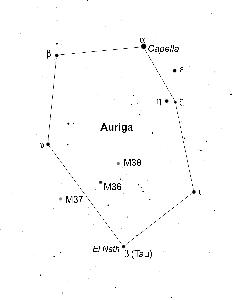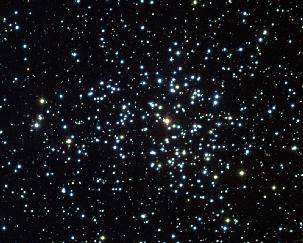Auriga
The constellation Auriga comes high in the northern sky in winter, but is only low above the northern horizon for southern observers in their summer. It lies along the plane of the milky way and thus is where one might expect to find rich star fields and open star clusters - their stars recently formed from the dust and gas lying within the plane. Auriga contains three open star clusters M36, M37 and M38. The most impressive of these is M37 - an A-List object.
M37 Open Cluster B M
M37, the largest, richest and brightest of the three Auriga clusters, was observed by Charles Messier in 1764. The cluster covers a 25 arc minute field and had a visual brightness of 6.2 so might just be glimpsed by the unaided eye under perfect conditions. It is easily picked up in binoculars, lying just to the west of the line between ? Aurigae and Alnath (?) Auragae. It gives a lovely view with a telescope at medium power and contains over 500 stars; of which some 150 are brighter than 12.5 magnitude and thus individually visible in a small telescope under transparent skies.
One can estimate the age of an open cluster by plotting its Hertzsprung-Russell diagram (a plot of luminosity against temperature) and seeing at what point stars are no longer seen on the main sequence. More massive, and hence brighter, stars leave the main sequence sooner. M37 has at least a dozen Red Giant stars that have evolved away from the main sequence and the brightest stars still on the main sequence are just hotter than type F. This gives an estimated age of about 300 million years. Its distance is not well known and is of order 4,500 light years. Given its angular diameter this gives an overall size of the cluster of about 23 light years.
Position: 05h 52.4m +32deg 33min
Other Messier Objects in Auriga
Sweeping northeast of M37, binoculars will pick up the two other open clusters. M36 is reached first. It is smaller than M37, about 14 light years across, and contains perhaps some 60 stars. The brightest are 9th magnitude and are more massive that those seen in M37. It is thus younger, around 25 million years old and lies at about 4000 light years away. Continuing in the same direction M38 will be seen. It lies at a similar distance to M37 but, at 7.4 magnitude, less bright. About 220 million years old, the brightest star amongst the 100 or so members of the cluster is a yellow giant of magnitude 7.9.
Positions
M36: 05h 36.3m +34deg 08min
M38: 05h 28.7m +35deg 51min





